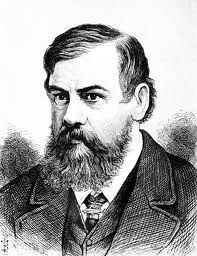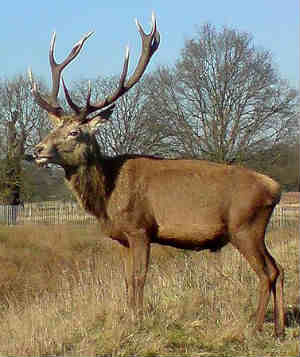Deer-cow Hybrids
Mammalian Hybrids
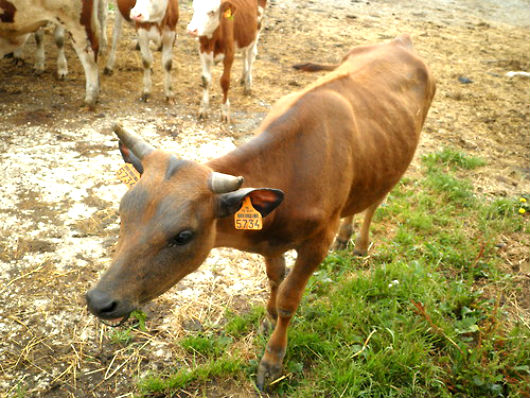 An ostensible deer-cow hybrid photographed in France in 2013. Lon MacGregor, who took this picture, notes that in comparison with a cow this animal is browner, has harder, shorter hair, more pronounced horns at a younger age, a more deer-like head, and thinner legs.
An ostensible deer-cow hybrid photographed in France in 2013. Lon MacGregor, who took this picture, notes that in comparison with a cow this animal is browner, has harder, shorter hair, more pronounced horns at a younger age, a more deer-like head, and thinner legs.
|
Some old red deer seems to have taken erratic courses about the ancient haunts of the Wolf of Badenoch.
—J. Brodie Innes
Letter to Charles Darwin, Jan. 28, 1870 |
(This article is part of the support material for the alternative theory of evolution offered on this website.)
There are many reports about cows being impregnated by stags, though the reciprocal cross, bull × doe, never seems to occur, perhaps because does are too frail to be mounted by bulls. Possibly, too, if such matings do ever occur, any resulting hybrids fail to be reported since their mothers would calve in the woods.
Most such crosses seem to involve red deer sires or, as they are known in North America, elk. But such is not always the case. At any rate, many reports about deer-cow hybrids are quoted below. Hybrids of this sort are often called "dows."
The next case appears in the Dutch language video below, which is about a probable deer-cow hybrid born in Holland in 1963. An English translation of the video appears directly below it.
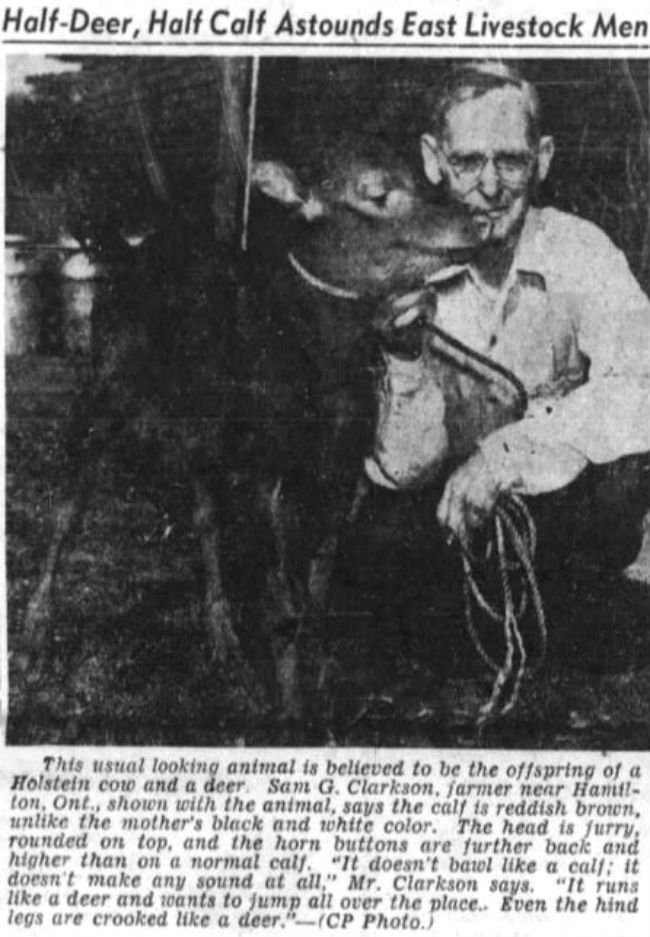 Above: A report about a deer-cow hybrid in the Calgary, Alberta, Herald (Apr. 18, 1949, p. 10; ||y6yvvgdf).
Above: A report about a deer-cow hybrid in the Calgary, Alberta, Herald (Apr. 18, 1949, p. 10; ||y6yvvgdf).
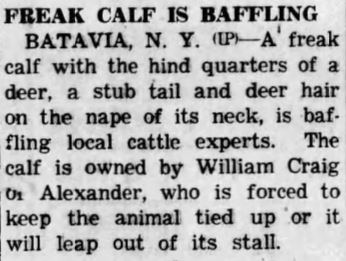 Above: A report about a deer-cow hybrid in the Napa, California, Journal (May. 2, 1939, p. 7, col. 4; ||y2j8lxzl).
Above: A report about a deer-cow hybrid in the Napa, California, Journal (May. 2, 1939, p. 7, col. 4; ||y2j8lxzl).
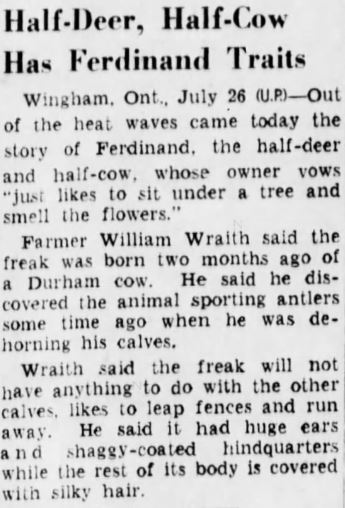 Above: A report about a deer-cow hybrid in the Brooklyn, New York, Daily Eagle (Dec. 9, 1939, p. 22, col. 5; ||y32ge5y8).
Above: A report about a deer-cow hybrid in the Brooklyn, New York, Daily Eagle (Dec. 9, 1939, p. 22, col. 5; ||y32ge5y8).
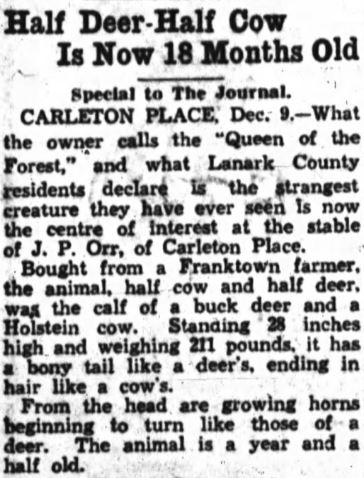 Above: A report about a deer-cow hybrid in the Ottawa, Ontario, Journal (Dec. 9, 1932, p. 3, col. 1; ||y64jghpq).
Above: A report about a deer-cow hybrid in the Ottawa, Ontario, Journal (Dec. 9, 1932, p. 3, col. 1; ||y64jghpq).
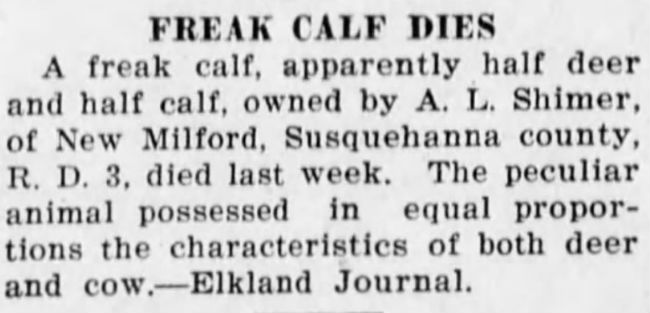 Above: A report about a deer-cow hybrid in the Coudersport, Pennsylvania, Potter Enterprise (Mar. 4, 1926, p. 2, col. 3; ||y3zuwxr3).
Above: A report about a deer-cow hybrid in the Coudersport, Pennsylvania, Potter Enterprise (Mar. 4, 1926, p. 2, col. 3; ||y3zuwxr3).
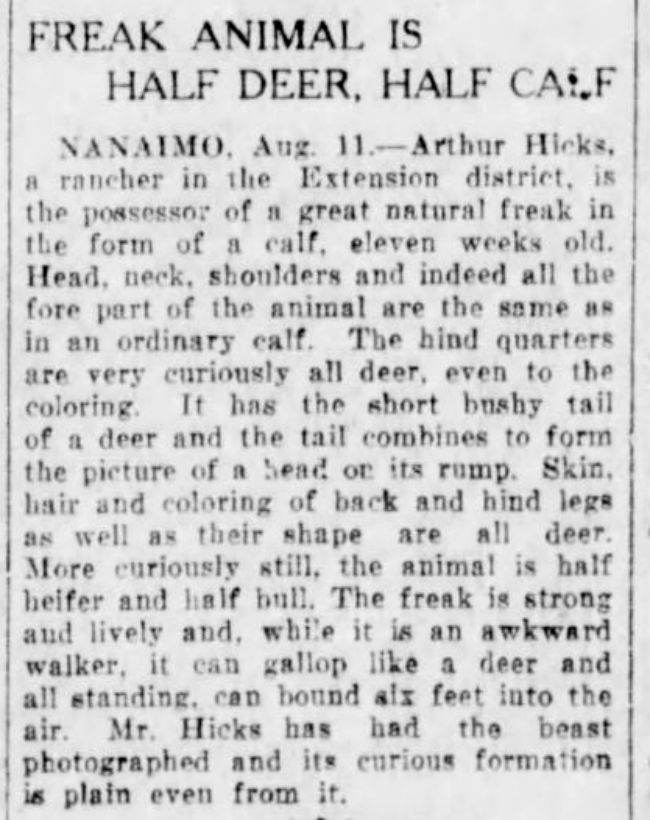 Above: A report about a deer-cow hybrid in the Vancouver, British Columbia, Daily World (Aug. 13, 1909, p. 5, col. 6; ||yylr3c4d).
Above: A report about a deer-cow hybrid in the Vancouver, British Columbia, Daily World (Aug. 13, 1909, p. 5, col. 6; ||yylr3c4d).
Chester. The following notice appeared in the Barre, Vermont Daily Times (May 4, 1905, p. 7, col. 3):
Neupest. Another description of a deer-cow hybrid appeared in the April 19, 1887 issue of the Viennese newspaper Welt Blatt (p. 5, col. 2). It reads as follows:
Alschbach. And another such report of appeared four years earlier in the August 23, 1883, issue of the same newspaper (Welt Blatt, p. 5, col. 1). It reads as follows:
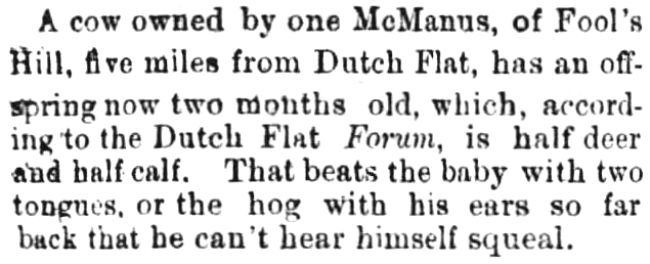 Above: A report in the Rocklin, California, Placer Herald (Dec. 23, 1876, p. 5, col. 1; ||y2jaaj9c).
Above: A report in the Rocklin, California, Placer Herald (Dec. 23, 1876, p. 5, col. 1; ||y2jaaj9c).
Advertisements. During the late 1850s, advertisements in various German language newspapers announced upcoming exhibits of a deer-cow hybrid (ad #1, ad #2, ad #3). This may have been the same animal described in an 1857 news notice as “half cow, half red deer, both parts living and nearly full-grown.”
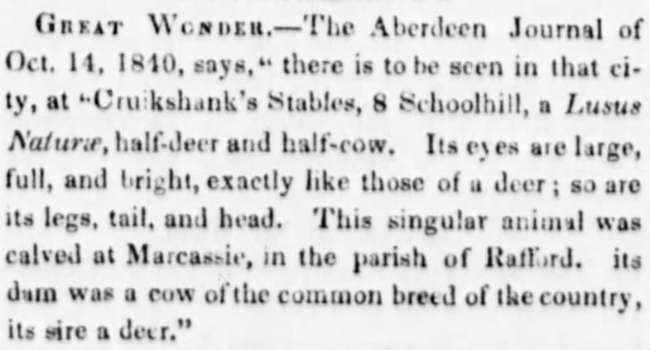 Above: A report in the Sunbury, Pennsylvania, newspaper the Sunbury American (Jul. 30, 1840, p. 1, col. 4; ||y4z5z5q5).
Above: A report in the Sunbury, Pennsylvania, newspaper the Sunbury American (Jul. 30, 1840, p. 1, col. 4; ||y4z5z5q5).
Wolfsberg. Another article about a deer-cow appeared in the June 11, 1847 issue of the Viennese journal Die Gegenwart, (no. 133, p. 612, col. 2). It reads as follows:
Another account of a deer-cow hybrid appears in Burdach (1839, p. 184), and another, in Laurop and Fischer (1820-1821. pp. 124-127). In all of these alleged crosses, the reported sire was a stag.
St. Germain. Nicolas de Blégny (1652–1722), personal physician to King Louis XIV, describes (see: Planque 1762, p. 511) a deer-cow mix he saw in 1698 at the St. Germain Fair in Paris. Overall the animal, a male, looked like a bull with the muzzle and pelt of a deer. In addition, de Blégny says, in the middle of his back he had a well-formed deer leg, which was attached to a male member about a foot long, including two testicles. There was also a cavity of considerable size in the top of his head, and the end of his tail was split so that it was double. This phenomenon of a hybrid, which has the overall appearance of one of its parents, having one or more appendages that are similar to those of the other parent (“exterogenetic parasitic attachments”), and, often, seemingly randomly attached, is seen in various other distant hybrids (example #1, example #2, example #3, example #4, example #5)
(1584-1659)
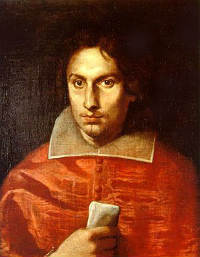 Cardinal Barberini
Cardinal Barberini(1607-1671)
Rome. Paul Zacchias (1661, p. 502), personal physician to Pope Innocent X, says he saw such a hybrid at Rome: “His eminence Cardinal [Antonio] Barberini has an animal born of
This may have been the same deer-cow that Kaspar Schott (Physica curiosa, 1667, p. 600) mentions, which he says he saw at Rome in the year 1654.
Lucerne. In his Historia naturalis Helvetiae curiosa, Johann Jacob Wagner (1653, p. 188) lists even earlier cases saying that "In the Alps it sometimes happens that the deer in rut are driven to copulate with cows and, as a result, [hybrids that he calls] moschelaphi are produced, animals that are like calves in their foreparts, but like true deer behind." He records births of such animals at three different Swiss localities, one on Mount Pilatus above Lucerne in 1649, another in the Entlebuch District in 1653, and the third at Benken in 1606.
And there is also a report of a much earlier date. Gerald of Wales (Topographia Hibernica, § II, ch. xxii and Itinerarium Cambrensis, II, ch. xi) describes a cow-deer born at Chester, England in the late 12th century: “Of a cow-deer. In our own time, at Chester
in England, a deer accosted a cow and from this union a cow-deer was produced. The anterior portion of the animal all the way back to the genital organs was like a cow. But the hips, tail, hindlegs and feet had the hair and color of a deer. But because it preferred cattle to the wild deer it remained with them in the domestic herd.† [Translated by E.M. McCarthy. Original Latin (from Topographia Hibernica): “De vacca cervina. Apud Cestriam Britanniae, temporibus nostris, ad vaccam cervus accesserat; unde et vacca cervina processit. Parte enim anteriore tota usque ad inguina bos erat; coxas subinde cum cauda, tibias, et pedes, expresse cum pilositate et colore cervinos habens. Sed quia plus pecoris quam ferae preferebat, inter armenta resedit” Brewer (1861-1891, p. 109).]
†. It's typical for hybrids to herd with the mother’s kind.
Darwin's Deer-cow Hybrid
In his Log-book of a Fisherman and Zoologist (1876, pp. 196-197), the English surgeon, zoologist, popular author and natural historian, Frank Buckland (Francis Trevelyan Buckland), gives the following account: “I must not in this chapter omit to mention a curious instance of a supposed hybrid between a cow and a red-deer which came under my notice. When inspecting
the river Beauly, near Inverness, Lord Lovat kindly asked me to examine a supposed hybrid between a red-deer stag and a cow, which was in the cow byres at Beaufort Castle. The animal was standing in a straw-yard. With its head turned away, it was like an ordinary black Scotch cow, but when she turned her head I was amazingly struck with the very deer-like appearance of the face, which the set-on of the ears, the oblong Chinese-like eyes, and the narrow prolongated muzzle, increased.
The story is that a cow was kept in a distant locality, where she could have access to none of her own species, but that there were red-deer stags about. A calf was unexpectedly born in which the deer features appeared. This calf has now grown up into the animal, as above described, which was then four years old. The herdsman told me that the other cattle would never associate with it; and in fact, when he drove it into the cow-shed, in order to tie it up for me to examine, the other animals turned their heads, and snorted at it.
The voice is not like that of the other cattle; it is a short noise like “ump!” “ump!” The action when trotting is somewhat higher than that of an ordinary cow. There are no horns, but a bony knob of a somewhat triangular shape between the ears. Although the resemblance to the deer about the head is exceedingly remarkable, I cannot bring myself to believe that it is a true hybrid.
This same animal, and another like it, are discussed in letters from John Brodie Innes to Charles Darwin. Innes was one of Darwin’s friends and, until 1862, vicar of Darwin’s home village of Downe. In that year he inherited an estate in Scotland and went there to live. From his new home, Innes maintained a correspondence with his friend back in Downe. The following is the text of one of his letters to Darwin, dated Dec. 7, 1868:
If this is a curiosity and anything occurs to you to ask I will put the questions, or you could ask them of Mr. McLean V.S. Inverness.
Mr. Key, a corn merchant in Forres told me he had once before seen a beast of the kind but it was not such an ugly one as this.
Believe me Dear Darwin.
Yours faithfully,
J. Brodie Innes
The following is the text of Dr. McLean’s response to Innes, dated Dec. 15, 1868.
J. Brodie Innes Esqr.
Sir,
I beg to be excused for being so long in answering your letter of the 8th, which I duly received.
As to your query whether the cow was sent to a Bull, or whether there was a Bull going along with the cow — I can not in the meantime answer — Mr. McDonald told me that the woman had only one cow — in the neighbourhood of a deer forest — the head of the animal resembles altogether that of a deer — the teeth ar[e] differently set from those of a cattle beast — the eye is distinctly that of a dee[r]—in short the head and ears are quite different from that of a cow — the ears are perfectly bare of hair — the ligamentum nuchae† is much stronger than that of a cattle beast of the same age — the cervical vertebra is also peculiarly that of a deer — the general construction of the trunk is such as a cattle beast of the same age would have — with the exception of the dorsal spines which are much longer.
The extremities — again differ completely from those of a cattle beast — the bones being much smaller and finer — the muscles being harder and much more of a tendonous construction — Showing a peculiar adaptation for speed — there are several parts of the body in the meantime perfectly free of hair — particularly the extremities — My own impression is that when the animal casts its coat in spring it will be almost bare of hair — the gait more resembles that of a deer than that of a cattle beast — the hair in the meantime is soft and silky — Any more Information I will gladly give.
Your obedient Servant,
S. McLean
† The ligamentum nuchae is a large ligament extending from the vertebrae of the neck to the back of the head in many mammals.
In a letter to Darwin dated Dec. 18, 1868, Innes mentioned that he had forwarded McLean’s letter.
In a subsequent letter to Darwin, dated Jan. 28, 1870, Innes included a clipping from a Scottish newspaper, the Elgin Courant, which mentions the same animal described by Frank Buckland in the passage quoted above.
The text of the letter itself reads as follows:
Dear Darwin,
The above is from the Elgin Courant of this day 28th Jan., 1870. I have not seen the animal. It is satisfactory to know that the former one, which I told you of before and which seemed if not a hybrid, a wonderfully good imitation of one has gone to a menagerie where perhaps in life or death the truth of its origin may be tested. Some old red deer seems to have taken erratic courses about the ancient haunts of the Wolf of Badenoch.
Faithfully Yours
J. Brodie Innes
Roe deer crosses
Note that Innes, above, stated that the Blervie animal was a “cross between a Highland cow and a red deer or roe.” Other reports of the latter of these two crosses, cow × roe deer (Bos taurus × Capreolus capreolus), exist. One appears in the July 20, 1911, issue (p. 7, col. 3) of the Salzburger Volksblatt, a newspaper published in Salzburg, Austria:
Passau is a town in Lower Bavaria, Germany near the Austrian border.
The incidence of stump appendages seems to be elevated in distant hybrids.
Another appears in the February 13, 1876 issue (p. 4, col. 2) of the Viennese newspaper Welt Blatt:
Brzeg (former German name: Brieg) is a town in southwestern Poland. Schurgast (now Skorogoszcz) is a village about 20 km (12 mi) southeast of Brzeg.
Another report of such a hybrid appears in the April 16, 1905 issue (p. 4, col. 4) of the L'Ouest-Éclair, a newspaper published in Rennes, France:
A FREAK. — Right now in Châteaubriant there is an extremely odd animal at La Jandelays, the farm of a M. Peluet. This animal, born of a cow, and which is nearly naked, has the head of a roe deer and the feet of a roe deer doe. The hair on its back is like that of a horse.
This singular creature is in good health and can be seen at La Jandelays.
[Translated by E. M. McCarthy. Original French.]Châteaubriant is a town in western France, about 350 km (220 mi) southwest of Paris.
Masnières, France Le Grand écho du Nord de la France (Lille, Jun. 18, 1911, p. 4c; ||3s43v23h) said a farmer at Masnières, one Oscar Bail, had a cow that calved an animal with the head of a roe deer. It soon died.
Roëllecourt, Pas-de-Calais, France. The newspaper Istanboul (Constantinople, Sep. 1, 1927, p. 2d; ||2pjrnw69) said an animal calved at Roëllecourt was a mix of cow and roe deer, but mostly like the latter. It was lively and alert and leapt about like a deer.
Since all of these reports about roe deer × cattle hybrids refer to young animals, it may be that the actual cross involved was red deer × cow since it would probably be difficult to distinguish between the two possibilities in animals of that age. It should be kept in mind that a red deer is easily large enough to cover a cow, whereas a roe buck is not.
White-tailed crosses
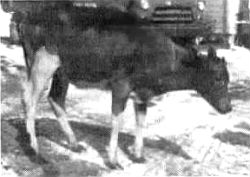 The Byron hybrid (source).
The Byron hybrid (source).
Byron. Dating to the 1960s, a report about a supposed cross between a white-tailed deer (Odocoileus virginianus) and cow appeared in Farm Show Magazine in 1991 (vol. 15, no. 2, p. 34), which is pictured at right. In a letter accompanying this picture, the owner, Mr. Jennings Anderson of Mineral Point, Wisconsin, states the following:
A 1905 report about a Minnesota deer with a cow’s tail >>
The following reports, although they do not specifically identify the type of deer involved in the cross, on the basis of the locales mentioned, probably also refer to a cross involving a white-tailed deer.
Oklahoma. Another report appeared in the Leavenworth, Kansas, Times (Apr. 21, 1893, p. 2, col. 5):
A Strange Monstrosity
The only deer native to southern Oklahoma, the site of the Chickasaw Nation, is the white-tail. The same is true of Maryland, the locale in the next two reports:
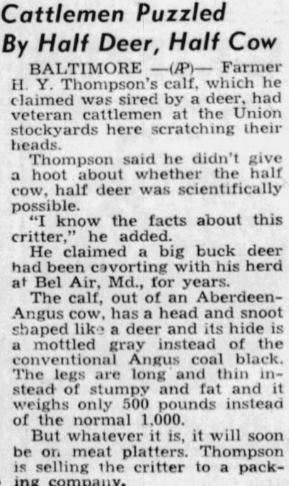 Above: A report about a deer-cow hybrid in the La Crosse, Wisconsin, Tribune (Apr. 23, 1948, p. 1, col. 5; ||y2vw64eo).
Above: A report about a deer-cow hybrid in the La Crosse, Wisconsin, Tribune (Apr. 23, 1948, p. 1, col. 5; ||y2vw64eo).
Another report, about a different deer-cow, from the Wilmington, Delaware, Daily News (Jan. 2, 1953, pp. 1 & 3; ||y5eh3abl & ||y339hsvm):
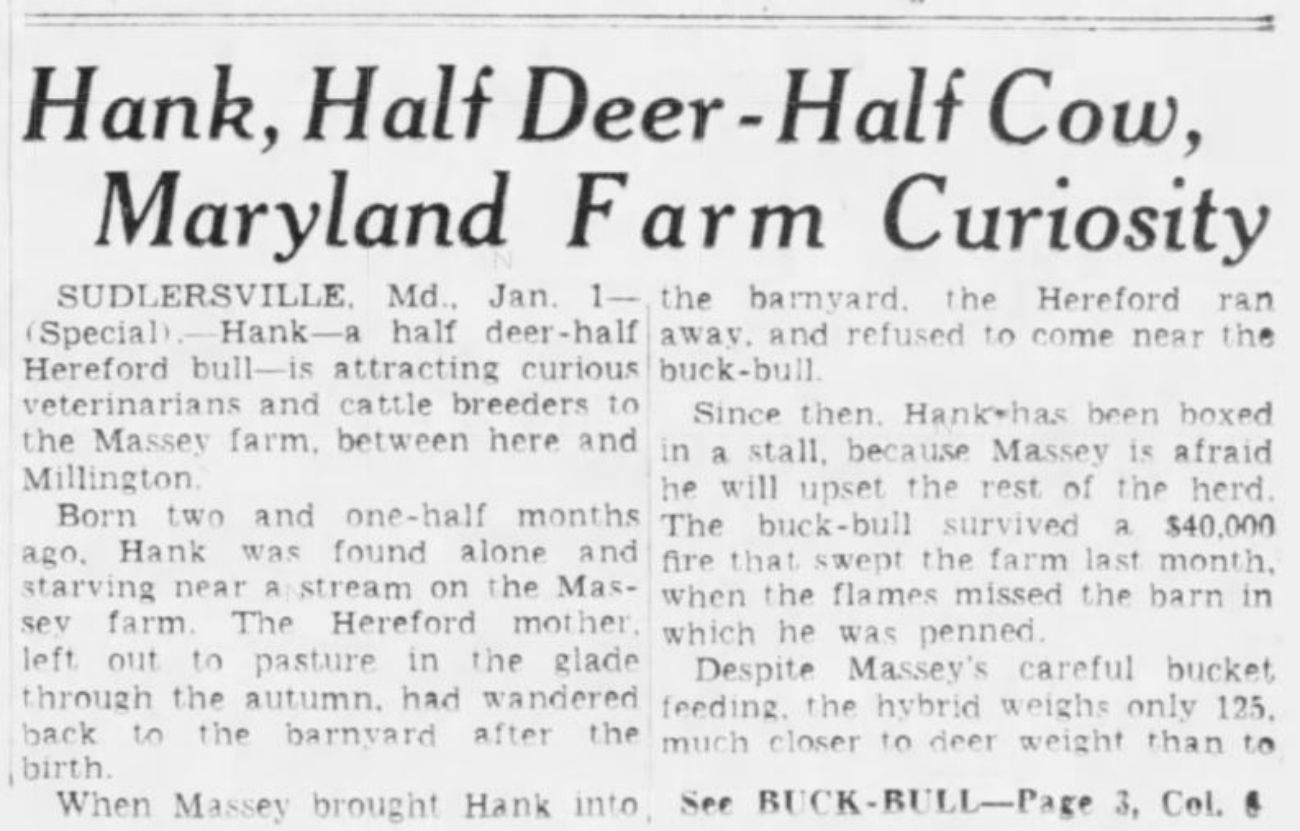
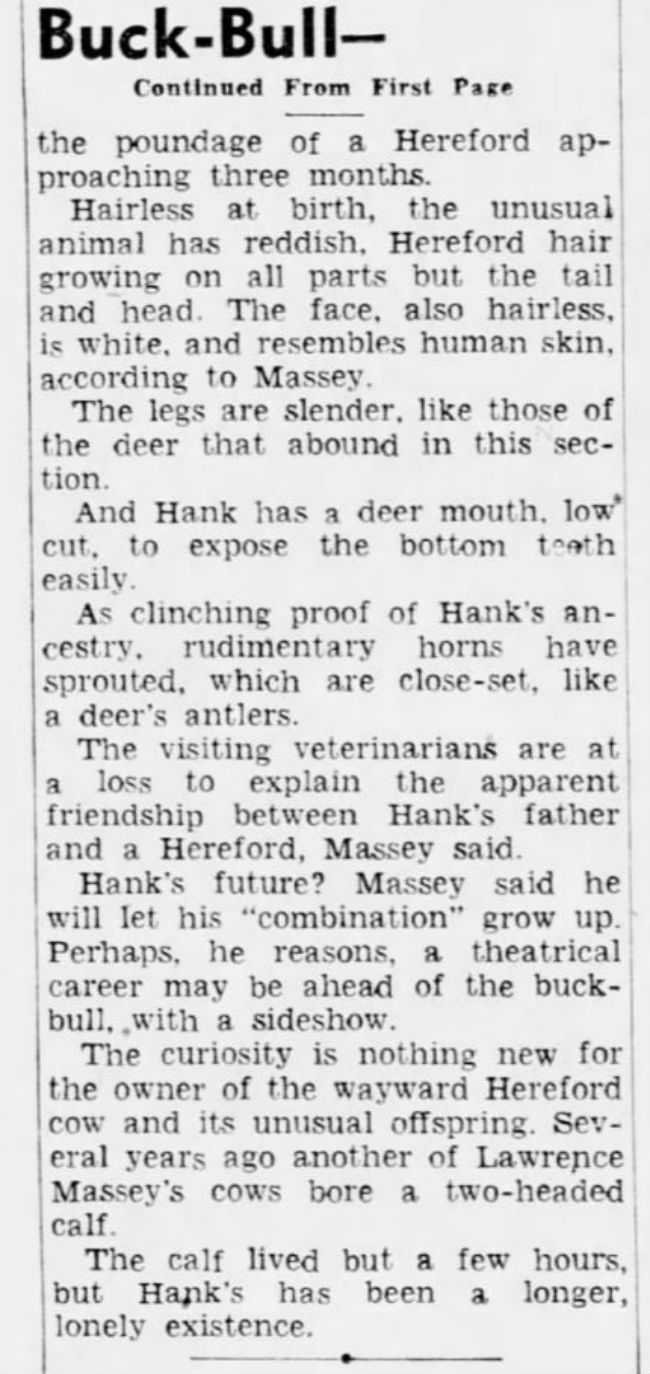
Webber, Kansas. Another report about what would presumably have been a hybrid involving a white-tailed sire, appeared in the Akron, Ohio, Beacon Journal (Sep. 9, 1953, p. 5):

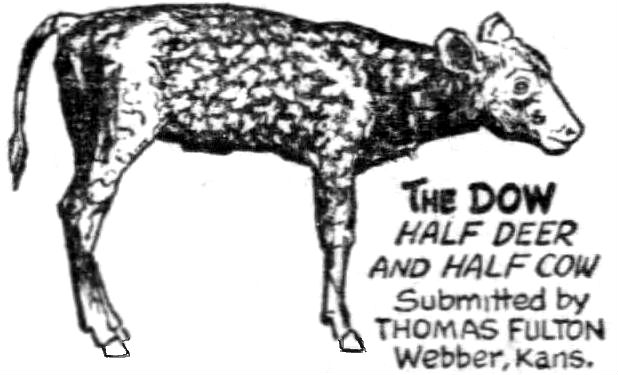 Above: A picture of the Webber deer-cow as it was depicted in Ripley's Believe It or Not in the Star Press (Muncie, Ind., Jun. 13, 1955, p. 11; ||y4ubcfjm).
Above: A picture of the Webber deer-cow as it was depicted in Ripley's Believe It or Not in the Star Press (Muncie, Ind., Jun. 13, 1955, p. 11; ||y4ubcfjm).
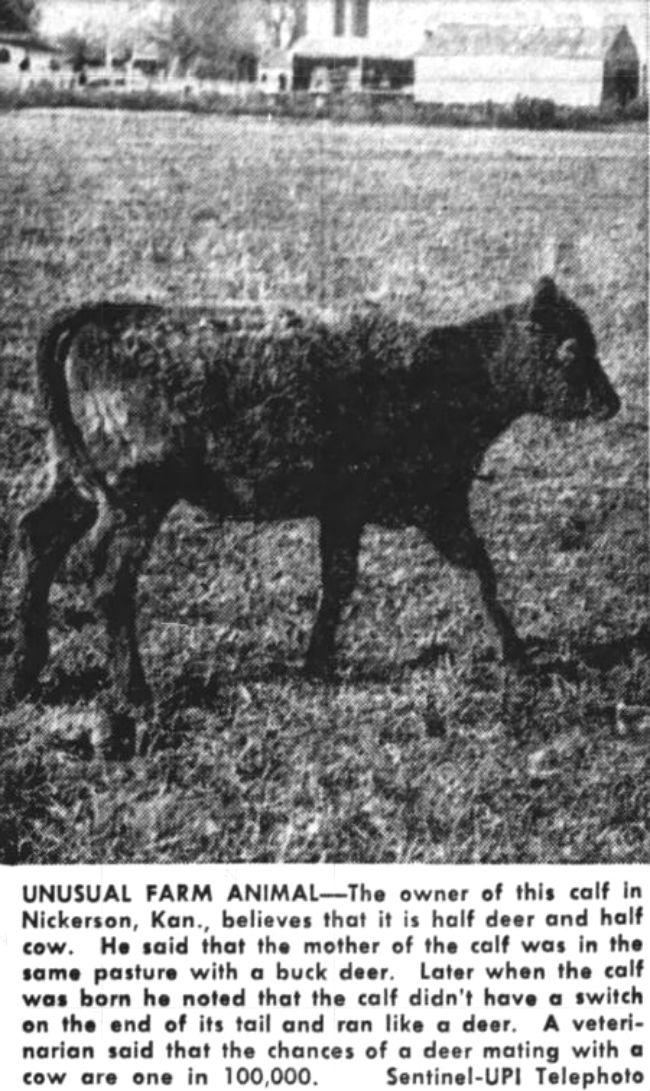 Above: An alleged dow pictured in the Sentinel (Carlyle, Pa., Dec. 22, 1964, p. 19; ||y3ba8z3s).
Above: An alleged dow pictured in the Sentinel (Carlyle, Pa., Dec. 22, 1964, p. 19; ||y3ba8z3s).
 Above: A report from the Bennington Evening Banner (Bennington, Vt., Aug. 29, 1925, p. 8; ||mhj87fhc
Above: A report from the Bennington Evening Banner (Bennington, Vt., Aug. 29, 1925, p. 8; ||mhj87fhc
Grantsville, West Virginia. Another white-tailed report, appeared in the Wheeling, West Virginia, Daily Intelligencer (Apr. 8, 1879, p. 1, col. 3):
Another in the Middlebury Register (Middlebury, Vt., Aug. 10, 1906, p. 5d; ||lcul47w). And another in the Gold Hill News (Gold Hill, Ore., Nov. 29, 1902, p. 2b; ||8xy5rzac).
Incertae sedis ("deer" x cow)
Springdale. The following report about a fawn born to a cow appeared in the Enterprise (Healdsburg, Ca., May 25, 1918e). If the story is accurate, the “fawn” can be interpreted as a deer-cow hybrid, since hybrids sometimes closely resemble only one of their parents, which in this case would be the deer sire. Though elk (Cervus elephas) do occur in Washington, note that the type of deer is not specified. White-tailed deer (Odocoileus virginianus) and mule deer (O. hemionus) also occur in the vicinity of Springdale.
La Bretonnière, France. L'Ouest-Éclair (Rennes, Oct. 11, 1935, p. 9b; ||yck4xyvt) said a cow at the village of La Bretonnière gave birth to a calf with three legs. The single foreleg, it said, was that of a deer.
JERSEY COW GIVES BIRTH TO A FAWN
Springdale, Wash., April 27.—Giving birth to a fawn, a Jersey cow on the ranch of G. R. De Vries, five miles from Springdale, a few weeks ago provided a freak of nature never before heard of, according to De Vries. “It is a deer in every particular,” he said.
“It is a deer in every particular,” he said. “The head is a trifle broader than that of a purebred fawn, but in every other particular it is perfect. It weighed only about ten pounds at birth, and is full of life, vigorous, and possesses all the characteristics of a fawn in its native forests. The mother is a purebred Jersey, 18 months old.”
“The hair is a mixture of white and red, and the ears lie well back on the head. I am sure it is a fawn. Its mother and grandmother have been running on the range some twelve to eighteen miles west of Springdale, on the eastern slope of the Huckleberry mountains, where deer are plentiful the year round.”
Florence. And in the news story below from the 1960s, another such animal is described, though again, from the report, it is not entirely clear what kind of deer was in question. Given the location (Florence, Montana), it might have been an elk, a white-tailed deer or mule deer.
HEREFORD OR DEER?
Hamilton, Mont. (AP)—A funny-looking animal has folks around the Bitterroot Valley in a tizzy these days.Folks here say the freak calf looks more like a fawn deer than a whiteface [i.e., Hereford].
Actually, the animal was born to a whiteface cow belonging to Mr. and Mrs. Clarence C. Wimple, who operate a ranch in cattle country near Florence.
The calf was born with long ears, a fuzzy spotted coat, slender nose, a rat-like tail, and slender, hard hooves. It has teeth like a calf, but unlike other Herefords, it hunts out a spot to lie down beneath some object, not out in the open.
Veterinarians and biologists say the animal is merely a freak of nature. But some skeptics still figure the calf was sired by a buck deer.
If so, what will the Fish and Game Department rule? Can the animal be slaughtered before hunting season? Will the owner be entitled to half the meat even though another hunter pulls the trigger?
One smart aleck says he would be satisfied with the udder half!
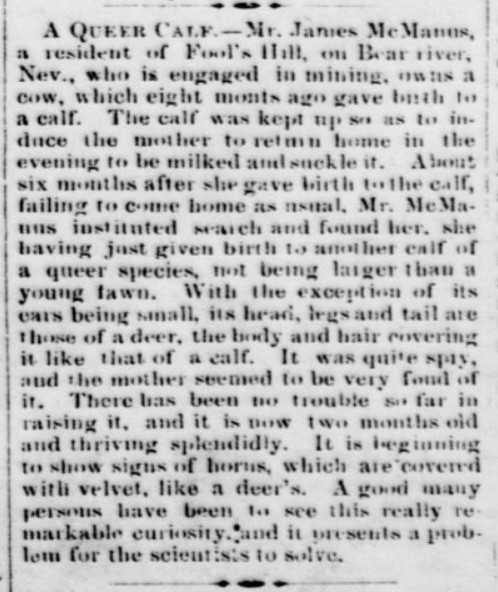 From the Cambria Freeman (Feb. 9, 1877, p. 1f).
From the Cambria Freeman (Feb. 9, 1877, p. 1f).
 Above: An old account of a deer-cow hybrid from The Cultivator: A Monthly Journal Devoted to Agriculture ..., 1841, Volume 8.
Above: An old account of a deer-cow hybrid from The Cultivator: A Monthly Journal Devoted to Agriculture ..., 1841, Volume 8.
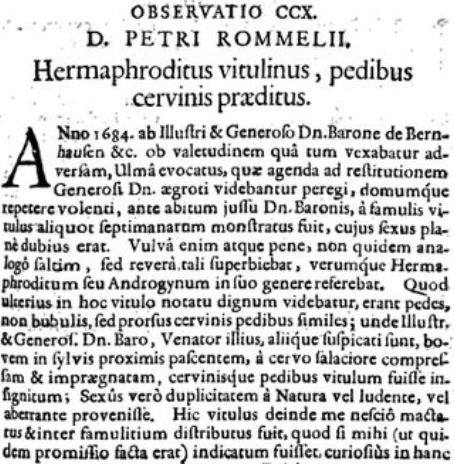 Above: An old account of a deer-cow hybrid. The author says this animal born of a cow, had feet exactly like those of a deer. In this case, the hybrid was a hermaphrodite, a condition often seen in hybrids. Source: Miscellanea curiosa, sive Ephemeridum medico-physicarum Germanicarum ... (Norimbergae, 1689), Dec. II, An. VII, p. 395, obs. CCX.
Above: An old account of a deer-cow hybrid. The author says this animal born of a cow, had feet exactly like those of a deer. In this case, the hybrid was a hermaphrodite, a condition often seen in hybrids. Source: Miscellanea curiosa, sive Ephemeridum medico-physicarum Germanicarum ... (Norimbergae, 1689), Dec. II, An. VII, p. 395, obs. CCX.
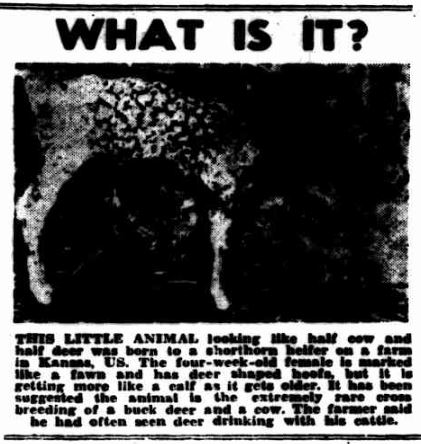 The article pictured above, which was bad in the online copy of the original newspaper, is from an Australian Newspaper the Broken Hill, New South Wales Barrier Miner (Jul. 30, 1953, p. 4), but refers to an event in Kansas, USA. Cervus elaphus has not occurred in Kansas since the early eighteenth century, so the deer in question here would be either Odocoileus hemionus or O. virginianus.
The article pictured above, which was bad in the online copy of the original newspaper, is from an Australian Newspaper the Broken Hill, New South Wales Barrier Miner (Jul. 30, 1953, p. 4), but refers to an event in Kansas, USA. Cervus elaphus has not occurred in Kansas since the early eighteenth century, so the deer in question here would be either Odocoileus hemionus or O. virginianus.
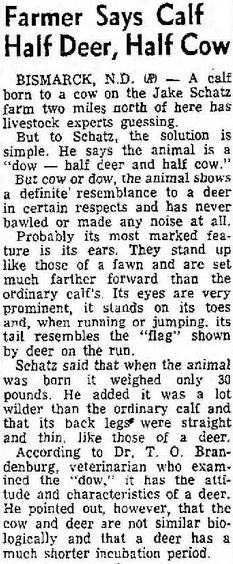 Above: An article in the Winona, Minnesota Republican Herald (Sep. 22, 1953, p. 16, col. 7).
Above: An article in the Winona, Minnesota Republican Herald (Sep. 22, 1953, p. 16, col. 7).
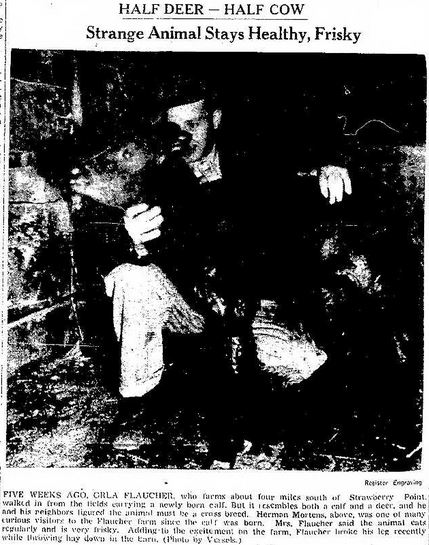 Above: An article in the Daily Register (Oelwein, Iowa, Nov. 15, 1950, p. 1) about a deer-cow hybrid born near Strawberry Point, Iowa. The image, from an old newspaper, was bad in the original.
Above: An article in the Daily Register (Oelwein, Iowa, Nov. 15, 1950, p. 1) about a deer-cow hybrid born near Strawberry Point, Iowa. The image, from an old newspaper, was bad in the original.
Most shared on Macroevolution.net:
Human Origins: Are we hybrids?
On the Origins of New Forms of Life
Mammalian Hybrids
Cat-rabbit Hybrids: Fact or fiction?
Famous Biologists
Dog-cow Hybrids
Georges Cuvier: A Biography
Prothero: A Rebuttal
Branches of Biology
Dog-fox Hybrids
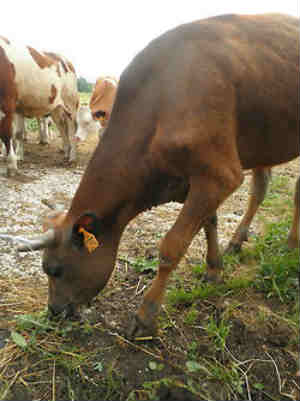
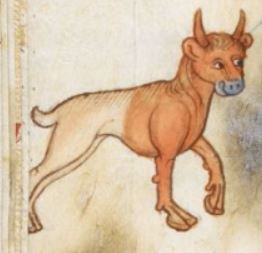 Enlarge
Enlarge